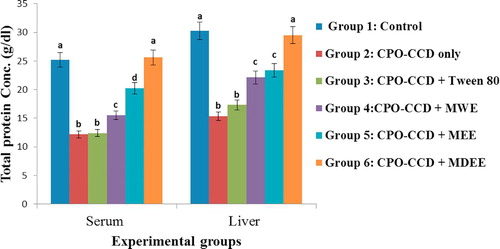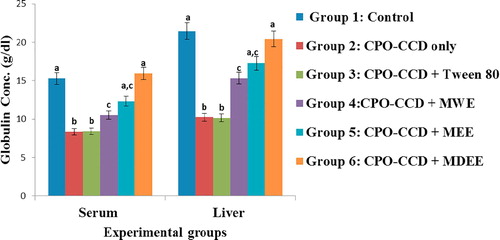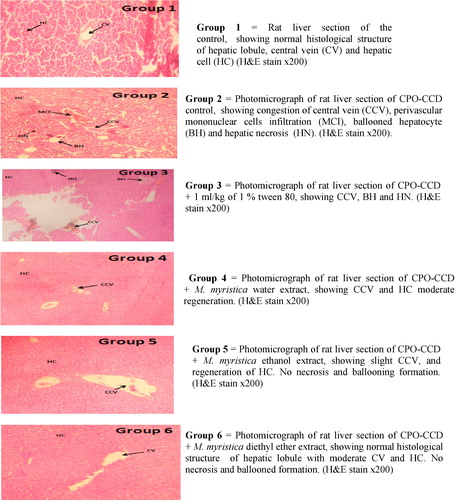 ?Mathematical formulae have been encoded as MathML and are displayed in this HTML version using MathJax in order to improve their display. Uncheck the box to turn MathJax off. This feature requires Javascript. Click on a formula to zoom.
?Mathematical formulae have been encoded as MathML and are displayed in this HTML version using MathJax in order to improve their display. Uncheck the box to turn MathJax off. This feature requires Javascript. Click on a formula to zoom.Abstract
Humans and animals are constantly exposed to crude petroleum contaminated diets in petroleum producing areas of the world. As a result, researches are on-going to find simple ameliorative agent against crude petroleum contaminated diet toxicity. The aim of this study was to evaluate the protective effect of Monodora myristica on some biochemical parameters of rats fed with crude petroleum oil contaminated catfish diet (CPO-CCD). Thirty male albino rats were separated into six groups of five rats as follows: group 1: control, group 2: rats were fed CPO-CCD only, group 3: CPO-CCD plus 1 ml/kg of 1 % tween 80, group 4: CPO-CCD plus M. myristica water extract (MWE), group 5: CPO-CCD plus M. myristica ethanol extract (MEE) and group 6: CPO-CCD plus M. myristica diethyl ether extract (MDEE). The feeding of the rats with CPO-CCD and administration of extracts orally lasted for 28 days. The results showed significant (P < 0.05) increase in aspartate aminotransferase (AST), alanine aminotransferase (ALT), alkaline phosphatase (ALP) in the serum and tissues (liver, kidney and brain) and decrease in total protein, albumin and globulin in the serum and liver of group 2 and 3 when compared with group 1. Significant (P < 0.05) decrease in AST, ALT, ALP activities and increase in total protein, albumin and globulin levels were observed after treatment with M. myristica extracts (group 4, 5, and 6) when compared with group 1. However, it could be concluded that MDEE revealed a strong effect when compared with the MEE and MWE.
1 Introduction
Crude petroleum oil (CPO) contains high amount of toxic chemicals, which can cause a wide range of health effects in people and wildlife, depending on the level of exposure and susceptibility [Citation1]. The constituents of crude petroleum oil are very complex. It contains aliphatic, alicyclic, polycyclic aromatic hydrocarbons, oxygen, sulphur and nitrogen containing substances [Citation2]. The polycyclic aromatic hydrocarbon content of CPO consists of fused aromatic benzene [Citation3].
Exposure of human and animals to these chemicals depends on different stage of CPO usage and environmental level [Citation4]. Crude petroleum oil has been reported as a mediator in oxidative stress [Citation5], which may lead to various dreadful diseases like cancer [Citation6], dementia, atherosclerosis, multiple sclerosis, cardiac dysfunction, blood disorders, hepatic morphological abnormalities [Citation6], nephrotoxic effects [Citation7], etc.
The use of antioxidant in ameliorating the deleterious effect of free radicals has been the subject of previous investigations [Citation8–Citation11]. Hence, use of spice with antioxidants property is necessary to suppress oxidative stress in a healthier way [Citation12]. Spice and herbs have been studied for their antioxidant activities. Although there are some studies on the antioxidant activity of M. myristica, its effect on CPO-CCD induced toxicity is scarce in literature. The study was carried out to examine the protective effect of M. myristica extracts on crude petroleum oil contaminated catfish (Clarias gariepinus) diet stimulated toxicity in rats. The findings of the study could be helpful to the inhabitants of the Niger Delta region of Nigeria and other parts of the world where CPO is produced to be enlightened on the benefit of including such antioxidant spice in their diet.
2 Materials and methods
2.1 Chemicals and reagents
Dichloromethane, ethanol and diethyl ether were all purchased from BDH chemical laboratory England. Anhydrous sodium sulphate was purchased from Sigma chemical company, London, England. ALT, AST, ALP, albumin and total protein kits were obtained from Randox laboratories limited (Antrim, England). All other reagents used were of analytical grade.
2.2 Spice
The spice M. myristica was purchased from the local market in Obiaruku, Delta State, Nigeria. The spice was identified at the Department of Botany, Delta State University, Abraka, Delta State, Nigeria.
2.3 Preparation of spice extracts
The spice (M. myristica) was sun-dried to constant weight for two weeks and then crushed into fine particles using electric blender. Extraction was carried out using one hundred grams of the powdered spice with 500 mL of the respective solvent (hot water (60 °C), ethanol (95% v/v), and diethyl ether, 95% v/v). The mixture was allowed to stand for 48 h and then filtered using a clean muslin cloth. The filtrate was evaporated to dryness using rotary evaporator attached to a vacuum pump. From the crude extracts (dry samples) one gram of each extract was dissolved in 9 mL aqueous tween 80 (1% tween 80 in 90 mL of distilled water (v/v). The samples were kept in the refrigerator at −4 °C.
2.4 Stimulation of crude petroleum oil pollution
The CPO was obtained from the Nigerian National Petroleum Cooperation (NNPC), refinery, and reported to have been extracted from Warri (Warri Excarvos light crude oil) in Delta State, Nigeria. The fish used for this study was collected from artificial pond in Obiaruku, Nigeria. They were allowed to acclimatize for 7 days and then divided into two groups.
Group 1: control: the catfish was cultured in plastic aquaria with 30 L borehole water for four weeks. Group 2: the catfish was cultured in plastic aquaria with 30 L borehole water and then polluted with crude petroleum oil (LD 50 toxicity in catfish, 823.3 µL/L) as described by Ikeogu et al. [Citation13] for four weeks. The water was changed and re-polluted every 24 h.
2.5 Formulation of diet
The formulation of diet was carried out by the method described by Sunmonu and Oloyede [Citation14]. The catfish were used as a source of protein (25%) to formulate diet for the rats, after it has been oven dried at 40 °C. The diet for each group was formulated using corn starch (52%), oil (4%), maize cob (4%), granulated refined sugar (10%) and vitamin/mineral mixture (5%).
2.6 Experimental procedure
Male albino rats were used for the study to avoid oestrous cycle complication. They were allowed to acclimatize for two weeks and had free access to water. The rats were supplied with standard growers mash diet gotten from Lagos State (Bio-Ingredients Limited Ikeja, Lagos). They were maintained in accordance with the National Institutes of Health (NIH) guidelines and then placed in six groups (5 rats each) as follows:.
Group 1: Control
Group 2: Crude petroleum oil contaminated catfish diet (CPO-CCD) control
Group 3: CPO-CCD plus tween 80
Group 4: CPO-CCD plus 200 mg/kg b. wt. of MWE
Group 5: CPO-CCD plus 200 mg/kg b. wt. of MEE
Group 6: CPO-CCD plus 200 mg/kg b. wt. of MDEE
Rats in groups 1–6 received tap water daily throughout the experiment and then sacrificed after 24 h fast on the last day of the study. The blood was collected into anticoagulant free test tubes. The organs were harvested immediately. One gram (1 g) of various tissues was homogenized in 10 mL of normal saline. After wards the clotted blood and the tissue homogenate were centrifuged at two thousand five hundred revolution per minutes (RPM) for fifteen minutes to separate the serum and tissues supernatants, which was stored in the refrigerator (−4 °C) for further biochemical analysis.
2.7 Biochemical analysis
2.7.1 Determination of total hydrocarbon content
The total hydrocarbon content in the catfish sample was determined using a modified method of Parageau et al. [Citation15]. Two grams (2 g) of catfish sample were extracted with 20.0 mL of dichloromethane (CH2 Cl2) then filtered using filter paper. The filtrate was collected in a clean dry pre weighed conical flask. The oil-solvent mixture was treated with anhydrous sodium sulphate, in order to remove the residual water from the extract. Fifty grams (50 g) of sodium sulphate was added and shaken vigorously to remove all traces of water that are present in the aqueous medium. The extract was reduced to a volume of 10 mL by evaporation. The total hydrocarbon content concentration in the sample was extrapolated from a standard curve obtained by the preparations of various concentrations of the crude oil (0.10, 1.0 and 10.0 mg/mL) with absorbance’s (0.01, 0.03 and 0.3) at a wavelength of 430 nm.
The total hydrocarbon content in the catfish was calculated using to the following equation:
C = Total hydrocarbon content (THC) (mg/kg), R = Concentration from graph, X = Sample (kg), D = Total volume of solvent
2.7.2 ALP assay
The method of Bessey et al. [Citation16] was used in the assay of ALP activity. Step 1, zero point five milliliters (0.5 mL) of alkaline phosphatase substrate was added in labeled test tubes and equilibrate to 37 °C for three minutes. Step 2, at time interval, 0.05 mL of each standard, control and sample was added to respective test tubes and mixed gently. Deionized water was used as sample blank and this was incubated for exactly ten minutes at 37 °C. Following the same sequence in step 2, 2.5 mL ALP colour developer were added at time interval and mixed well. Absorbance was read against reagent blank at a wavelength of 580 nm.
2.7.3 AST and ALT activities assay
The method of Reitman and Frankel [Citation17] was adopted for the assay of AST and ALT activities. Reagents were prepared according to standard procedures using commercially available diagnostic kits supplied by Randox Laboratories Limited, England. Into two test tubes labeled sample and blank were dispensed 250 μL of reagent 1. 50 μL of samples were added into sample test tubes and 50 μL of distilled water into blank then mixed. The mixtures were incubated for 60 min at 37 °C. Into each test tube, 250 μL of reagent 2 were added, mixed and incubated for 20 min at 20–25 °C. Into each test tube, 2.5 mL of working NaOH reagent were added, mixed well and allowed to stand for 10 min. Absorbance of the tested sample was read against reagent blank using spectrophotometer at a wavelength of 540 nm.
2.7.4 Determination of albumin level
Albumin level was analysed using the method of Doumas et al. [Citation18]. Three milliliters (3 mL) of 3, 3, 5, 5, - tetrabromo-m-cresol-sulphoepthalein (bromocresol green, BCG) regent were added to test tube labeled blank, standard and sample. Ten microliters (10 µL) of sample were transferred to respective tubes then mixed well and allowed to stand at room temperature for five minutes. The absorbance was read at 580 nm against reagent blank.
2.7.5 Determination of total protein level
The total protein level was estimated using the method of Tietz [Citation19]. One milliliter (1 ml) of total protein regent was added to test tube labeled blank, standard and sample, then 20 µL of sample were transferred to respective tubes and allowed to stand at room temperature for 30 min. The absorbance was recorded against reagent blank at 546 nm.
Globulin level was calculated; Globulin = total protein − albumin.
2.7.6 Liver histology analysis
The liver histology was carried out according to method of Zhang [Citation20]. The liver of rats were removed and rinsed with cold saline water. The liver was cut into smaller pieces (5 mm) and immediately fixed in 10% formalin. The blocks were prepared for section cutting with a microtome by paraffin wax. Sections of 5 to 7 μ thickness were cut and stained with hematoxylin and eosin (H&E) stain. The liver specimens were examined and then photographed under light microscope Leica DM 750 with a camera Leica ICC 50.
2.8 Statistical analysis
Descriptive statistics were carried on the data obtained from each parameter. Results were expressed as mean bars and mean ± SD. The significant differences between groups were analyzed using one way analysis of variance (ANOVA) and post hoc test. Dependence between parameters was measured using Pearson correlation (r). The SPSS-PC programme package (version 22.0) was used for statistical analysis. A significant threshold of P < 0.05 was regarded statistically significance between the test and control group for the analysis.
3 Results
3.1 Level of total petroleum hydrocarbon content in catfish polluted with crude petroleum oil
The mean value of total petroleum hydrocarbon content obtained in crude petroleum oil polluted catfish was significantly (P < 0.05) higher when compare with department of petroleum resource (DPR) limit ().
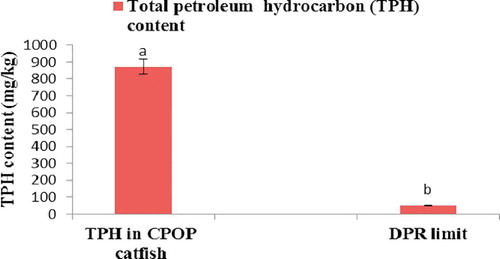
3.2 AST, ALT and ALP activities of rats fed CPO-CCD administered M. myristica extracts
Changes in AST, ALT and ALP activities in the serum and tissues (liver, kidney and brain) of rats fed CPO-CCD treated with M. myristica extracts are shown in – respectively. AST, ALT and ALP activities increased significantly (P < 0.05) in rats fed CPO-CCD only in serum and tissues when compared with the control. However, treatment with MWE, MEE and MDEE showed significant decrease in AST, ALT and ALP activities in the serum and various tissues when compared with CPO-CCD only. The correlation between AST and ALT in the serum was positive (r = 0.946).
Table 1 Aspartate aminotransferase activity of rats fed CPO-CCD treated with M. myristica extracts (mean ± SD).
Table 2 Alanine aminotransferase activity of rats fed CPO-CCD treated with extracts of M. myristica (mean ± SD).
Table 3 Changes in Alkaline phosphatase activity of rats given CPO-CCD treated with different extracts of M. myristica (mean ± SD).
3.3 Albumin, total protein and globulin levels of rats fed CPO-CCD treated with M. myristica extracts
Significant decreased level of albumin in the serum and liver were observed in rats fed CPO-CCD only when compared with control. Treatments with the extracts of M. myristica significantly (P < 0.05) increased the level of albumin in the serum and liver when compared with rats fed CPO-CCD only (). The total protein level in the serum and liver were significantly (P < 0.05) lower in rats fed CPO-CCD only when compared with control. However the altered total protein levels in the serum and liver were significantly normalized after treatment with MWE, MEE and MDEE (). A positive correlation was also observed between serum albumin and total protein (r = 0.935). Serum albumin and ALT was negatively correlated (r = −0.922). There were significant (P < 0.05) decreased in globulin level in the serum and liver of rats fed CPO-CCD only when compared with control. Upon treatment with the extracts of M. myristica (MWE and MEE) significant elevated globulin levels were observed in the serum and liver (). No significant (P > 0.05) difference was observed in globulin level in the serum and liver after treatment with MDEE when compered with the control.
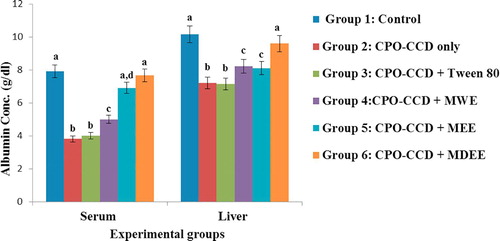
3.4 Effect of M. myristica extracts on the liver histology of rats fed CPO-CCD
The liver histological structure of rats in the control group showed normal hepatic lobule, hepatic cell (HC), and central vein (CV). Rat liver section of CPO-CCD control group indicated congestion of central vein (CCV), perivascular mononuclear cells infiltration (MCI), and ballooned hepatocyte (BH) (). Treatment with MWE and MEE, the rat liver sections showed CCV, and HC moderate regeneration. However, rats fed CPO-CCD treated with MDEE showed normal histological structure of hepatic lobule.
4 Discussion
Crude petroleum oil polluted catfish had high content of total petroleum hydrocarbon (PHC) than the department of petroleum resource (DPR) exposure limits [Citation21]. This observation suggests that consumption of crude oil contaminated diet exposes man and animals to hydrocarbon toxicity. This finding is in line with the study conducted by Nwaichi et al. [Citation22], who hinted that presence of petroleum hydrocarbon in the aquaculture environment is of global importance because they play potent role in fish bioaccumulation and transfer toxic and carcinogenic chemicals to humans.
That the consumption of petroleum contaminated diet is injurious to animal health is indicated by the increase in serum liver function enzymes ( and ). This is consistent with earlier studies [Citation8,Citation23]. The increase in serum liver enzymes has been attributed to damage to the liver cell membrane and cellular leakage of these enzymes into general circulation. This explains why a positive correlation was observed between AST and ALT (r = 0.946). Exposure to crude petroleum contaminated diet induced organ/tissue damage that is further expressed by the increase in alkaline phosphatase activities (). This finding is also in accordance with the studies of Adeyemi et al. [Citation24]; Momoh and Oshin [Citation25] which indicated that crude petroleum oil induced renal toxicity, damage to the plasma membranes and vascular endothelium of the brain. However, the activities of AST and ALT in various tissues of rats fed CPO-CCD treated with MDEE, MEE and MWE were restored close to control values. These observations therefore portray the protective effect of M. myristica extracts against damage to the plasma membranes of the tissues. The protective influence of plant materials against chemical toxicity was previously reported [Citation5,Citation26].
In addition, other markers of organ/tissue damage were affected by consumption crude oil contaminated diet. This is indicated by decreases in albumin, total protein and globulin levels in the serum of rats fed with CPO-CCD only when compared to control (–). Generally, the damaged liver by the contaminated diet is further highlighted by histological study. The hepatic histoarchitecture of rats fed CPO-CCD resulted in severe hepatic necrosis, congestion of central vein, perivascular mononuclear cells infiltration, and ballooned hepatocyte (; groups 2 and 3). The distortion of architectural integrity of damaged organs and tissues by petroleum was reported previously [Citation23]. The work of Sureshkumar and Mishra [Citation27] suggests that the damage produced results in failure of the endoplasmic reticulum, which leads to decrease in protein synthesis. The results are also in line with previous study conducted by Sunmonu and Oloyede [Citation14], who stated that crude petroleum oil contaminated diet may lead to reduced dietary intake and hence a reduction in serum albumin levels. The correlation between albumin and total protein was positive (r = 0.935). Negative correlation between albumin and ALT (r = −0.922) was observed. Similar to liver function enzymes, treatment with MDEE, MEE and MWE, the protein level was restored close to control values. The extracts may have stabilized the endoplasmic reticulum leading to protein synthesis which is in line with the previous work [Citation27].
The protective potency of polysorbates (tween 80), a known food additive, against crude petroleum oil contaminated diet induced liver toxicity was also evaluated. No change was showed in AST and ALT activities when rats fed CPO-CCD compared with rats fed CPO-CCD + tween 80, thus confirming the nontoxic effect of tween 80 with respect to liver function. This is in agreement with the statements of Gad et al. [Citation28], who reported that polysorbates are widely used in food products and topical pharmaceutical formulations, and are regarded as nontoxic materials.
5 Conclusions
It is pertinent to suggest that the CPO-CCD triggered hepatotoxicity and disturbance in the levels of hepatic enzymes activities and other tissues (kidney and brain) as shown in this study. However, administration of M. myristica extracts significantly rescued the CPO-CCD induced tissue damage and structural alterations. Moreover, the results of this study were able to establish that treatment with MDEE showed significantly higher protective effect as compared with MEE and MWE.
Competing interests
There is no competing interest to declare.
Notes
Peer review under responsibility of Faculty of Veterinary Medicine, Cairo University.
References
- C.O.UjowunduF.N.KaluR.N.NwaoguikpeR.I.OkechukwuC.E.IhejirikaThe antioxidants potentials of Gongronema latifolium on diesel petroleum induced hepatotoxicityJ Appl Pharm Sci220129094
- D.X.LiuX.T.ZhaoW.LiangJ.W.LiThe stability and breakage of oil-in-water from polymer flooding produced waterPet Sci Technol31201320822088
- K.G.DineshA review on processing of crude oil and its production of hydrocarbon intermediatesChem Technol Ind J112016105
- K.C.Patrick-AnyanwuC.C.OnyemaenuM.O.WegwuE.O.AyaloguHepatotoxic and nephrotoxic effects of kerosene and petrol-contaminated diets in Wistar albino ratsRes J Environ Toxicol520114957
- F.I.AchubaL.A.UboguB.O.EkuteMoringa oleifera attenuates crude oil contaminated diet induced biochemical effects in Wistar albino ratsUK J Pharm Biosci420167077
- A.KhanV.AnandV.BadrinarayananK.ThirunethiranP.NatarajanIn vitro antioxidant and cytotoxicity analysis of leaves of Ficus racemosaFree Rad Antiox72017812
- A.VyskocilM.CizkovaNephrotoxic effects of unleaded petrol in female ratsJ Appl Toxicol1619965556
- F.I.AchubaC.C.NwokogbaEffects of honey supplementation on hydrocarbon-induced kidney and liver damage in Wistar albino ratsBiokemistri2720155055
- F.I.AchubaE.O.OtuyaProtective influence of vitamins against petroleum induced free radical toxicity in rabbitEnvironmentalist262006295300
- F.I.AchubaP.E.AwhinProtective influence of antioxidant vitamins on hematological indices of rabbits fed crude-oil-contaminated dietToxicol Environ Chem912009505510
- B.I.OgnjanovićS.Z.PavlovićS.D.MaletićR.V.ZikićA.S.StajnR.M.RadojicićProtective influence of vitamin E on antioxidant defence system in rats treated with cadmiumPhysiol Res522003563570
- H.Ene-ObongN.OnuohaL.AburimeO.MbahChemical composition and antioxidant activities of some indigenous spices consumed in NigeriaFood Chem28320185864
- C.F.IkeoguC.I.NsoforI.O.IgwiloToxicity of lead nitrate and crude oil on the growth of the African catfish Clarias gariepinusInt J Agric Biosci22013337339
- T.O.SunmonuO.B.OloyedeChanges in liver enzyme activities in African catfish (Clarias gariepinus) exposed to crude oilAsian Fish Sci192006104109
- M.P.ParageauA.MirinF.SebyC.GuimonE.KruppC.PercheyranPartitioning of metals species during an enriched fuel combustion experiments, speciation in the gaseons and particulate phasesEnviron Sci Technol382004252263
- O.A.BesseyO.H.LowryM.J.BrockA method for the rapid determination of alkaline phosphatase with five cubic millimeters of serumJ Biol Chem1641946321329
- S.ReitmanS.A.FrankelColomentric method for determination of serum glutamic oxalacetic acid and glutamic pyruvic transaminasesAm J Clin Path2819575663
- B.T.DoumasW.A.WatsonH.G.BiggsAlbumin standards and the measurement of serum albumin with bromcresol greenClin Chim Acta3119718796
- Tietz NW, Fundamental of clinical chemistry. 3rd ed. Carl AB, Edward RA (ed.). W. B. Saunders, Co, 1999.
- C.ZhangX.TianK.ZhangG.Y.LiH.Y.WangJ.H.WangProtective effects of Foeniculum vulgare root bark extract against carbon tetrachloride-induced hepatic fibrosis in miceWorld J Gastroenterol23201757225731
- F.D.OgelekaO.EdjereA.NwuduE.F.OkieimenEcological effects of oil spill on pelagic and bottom dwelling organisms in the riverine areas of Odidi and Egwa in Warri, Delta StateJ Ecol Nat Environ82016201211
- E.O.NwaichiS.A.NtorgboAssessment of PAHs levels in some fish and seafood from different coastal waters in the Niger DeltaToxicol Rep32016167172
- F.I.AchubaM.D.OgwumuPossible protective role of palm oil and beef liver on the kidney and liver of wistar albino rats fed diesel-contaminated dietBiokemistri262014124129
- O.T.AdeyemiO.OsilesiO.O.AdebawoF.D.OnajobiS.O.OyedemiA.J.AfolayanAlkaline phosphatase (ALP), aspartate aminotransferase (AST) and alanine aminotransferase (ALT) activities in selected tissues of rats fed on processed Atlantic horse mackerel (Trachurus trachurus)Adv Biosci Biotechnol62015139152
- J.MomohT.T.OshinSevere hepatotoxicity and nephrotoxicity of gasoline (petrol) on some biochemical parameters in Wistar male albino ratsAm J Biochem52015614
- H.E.KadiriProtective effect of Vernonia amygdalina (bitter leaf) extract on rats exposed to cyanide poisoningBiokemistri.292017126131
- S.V.SureshkumarS.H.MishraHepatoprotective effect of extracts from Pergularia daemia ForskJ Ethnopharmacol1072006164168
- S.C.GadC.D.CassidyN.AubertB.SpainhourH.RobbeNonclinical vehicle use in studies by multiple routes in multiple speciesInt J Toxicol252006499521

